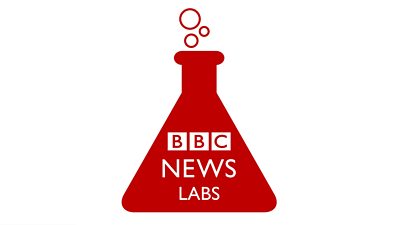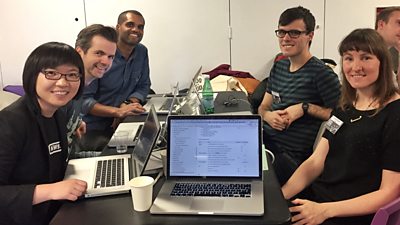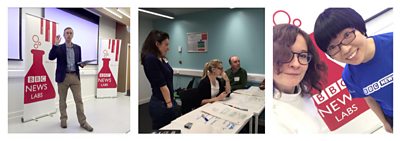
It’s been a big year in ±«Óătv News Labs writes Allison Shultes. We’ve delivered a number of products, from graphics reversioning tools to news bots, and we’ve worked with teams from the World Service to Visual Journalism to R&D to drive innovation forward within ±«Óătv News.
A big focus of News Labs in 2016 has been video reversioning and production workflows. We’re closing the year with a finished – a video translation workflow that allows journalists to reversion videos using text-to-speech technologies and synthesised voices.
We added new features that give the user more control over the pronunciation of the synthetic voices and the intelligibility of sentences. We’re getting ready to hand over the tool to production, where it will be maintained after being introduced into journalists’ day-to-day workflows.We’ve also begun successfully introducing our to , allowing producers to easily repurpose graphics templates and social videos with text overlays directly from their browsers.
This product speeds up the process of reversioning English-language graphics templates into a target language. Feedback from the head of the site, one of the first places where GraFix was introduced, has said that the tool will be “very, very useful” going forward, and we’ve heard from other World Service producers that GraFix has enabled even faster and more efficient workflows for ±«Óătv journalists.

In the realm of video tools for production, we’ve made significant headway on our , a project exploring media editing, repurposing and augmentation based on the results of intelligent analysis. We're using enrichment processes like automatic speech transcription, concept extraction and shot detection on ±«Óătv News production content and aggregating the results in a central repository, which then forms the basis of specialised tools. Going forward, we’re interested in exploring the automated generation of subtitles and repurposing of video content for users on low-bandwidth connections. has also been a success for our team. In November in collaboration with and the World Service — the corporation’s first news bot for . We plan to continue implementing new analytics in order to get a better understanding of how our audiences interact with a news bot service.

We also partnered with to make their graphics workflow on the night of major election votes more efficient. In the summer, we built a Twitter bot that automatically repurposes television graphics into shareable social media cards reflecting the most recent vote count in the . This autumn, so it could be used during the . We plan to hand off the product to Visual Journalism so that they can manage it without our support during elections in the future.

We’re still keeping our eyes on conversational user interfaces as we head into the new year. We’ve also gained experience developing more ambitious prototypes at hackathons that have introduced us to new technologies. A team of Labbers won the with an experimental pitch using a combination of text-to-speech and personality analysis services. held by allowed team members to experiment with multilingual API services and automatic graphics generation based on user input. We hope that these experiments might inform our work on bots in the future.

Even when trials of our projects haven’t gone as we expected this year, we’ve been able to learn from the process. Built in collaboration with , our automated attempts to generate a higher number of onward journeys from ±«Óătv News story pages than our current solution from a 3rd Party system. that we still have more work to do, it also spurred our first use of multivariate testing on ±«Óătv News story pages and consequently gives us an understanding of how to implement this type of testing in the future. News Labs has continued its support of hack events that bring together journalists and developers to solve problems around news. We started off the year with two University Challenge events at the and . We also held a for the , following off of a successful event in 2015. This autumn, we partnered with Connected Studio and , which is run out of Santa Clara University and funded by , to put on — a two-day hack to prototype solutions for building trust in online news attended by 60 journalists from organisations including , , and .

Our early plans for the new year include further exploring the potential for chatbot technologies for news, producing more tools for creating new types of content, exploring more atomised forms of storytelling and continuing to run hack days for students, journalists and developers.
More on News Labs: